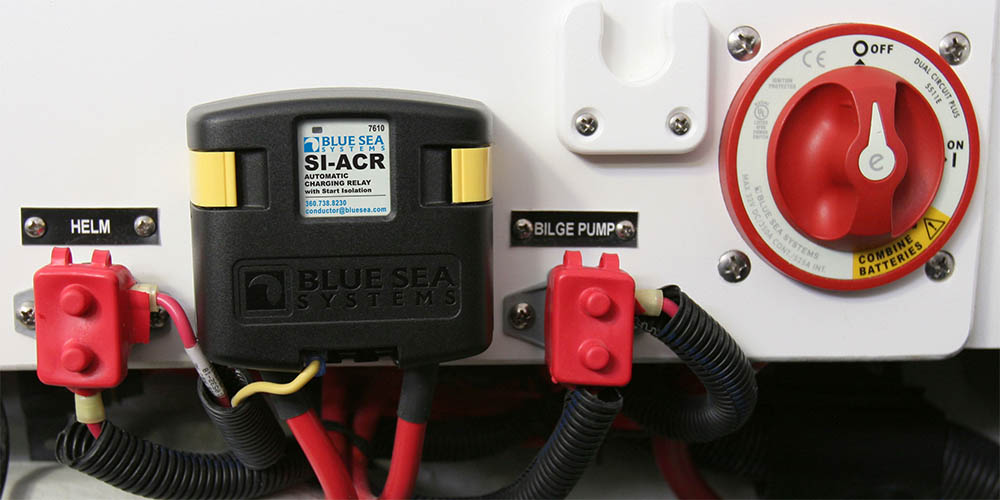
Tired of worrying about your trolling motor or sound system running your starting battery down? You need a dual boat battery setup. Luckily, adding a second battery to your boat is a relatively simple task that only requires a few products and tools. We'll run you through everything you need to know.
- Types of Marine Batteries
- Electrical Safety Precautions
- Where to Mount a Second Boat Battery
- Using Quality Battery Cables
- How to Make Your Own Battery Cables
- Battery Switches
- Charge Management
- Best Batteries for Dual Boat Battery Setups
Types of Marine Batteries
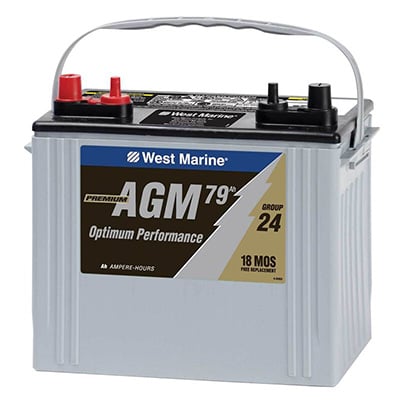
Sealed dual-purpose batteries combine the ability to withstand deep discharges with cranking power to start your engine
Starting batteries are similar to automotive batteries and are available in both flooded and sealed battery types. They can supply lots of current for a short period of time, but like to be recharged almost immediately and are not tolerant of deep discharges.
They are appropriate as the single battery for wakeboard boats, runabouts, personal watercraft and other boats with minimal DC loads where the engine is always running.
Deep-cycle batteries can endure repeated deep discharging and recharging without damage and are available in flooded and sealed battery types. Lithium deep cycle batteries are also a great option as they are lighter compared to lead-acid equivalents and provide consistent power throughout discharge.
They are appropriate for sailboats, fishing boats and all other boats with larger DC power requirements. Any battery used to power onboard DC loads such as lighting, trolling motors, inverters and other systems should be a quality deep-cycle battery, like our West Marine brand. Most boats with dual-battery systems use one starting battery and one deep cycle battery.
Dual-purpose batteries work well in some applications and are a good compromise because they tolerate deep discharges that would ruin a typical starting battery.
Since they have lower storage capacity than comparably-sized deep cycles, we recommend them for boats with two identical batteries used interchangeably for starting and house electrical loads. Dual-purpose batteries are also available in flooded or sealed battery types.
Electrical Safety Precautions
- Always disconnect the battery cables before working: Batteries contain a tremendous, and potentially dangerous, amount of stored energy. Whenever you are working on your electrical system, remove the positive battery cables from the battery terminals to eliminate the chance of a short circuit and/or possible electrocution
- Follow American Boat and Yacht Council (ABYC) safety standards: The ABYC publishes safety standards for circuit protection, wire sizes and other related issues in electrical systems. Make sure your install is compliant with all standards
- Make sure all connections are clean and the right size: It is imperative that you have low resistance connections. This means having clean metal-to-metal connections, the right size terminals which are properly crimped and waterproofed and secure mechanical fasteners.
- Don't use wingnuts for battery connections: For outboard engine applications we recommend replacing wingnuts on the tops of the battery with nylock nuts or hex nuts and lock washers that are tightened to at least 10-foot-pounds of torque. For inboard engine applications, you should use clamp-on battery terminals connected to the correct gauge of battery cable.
- Wear safety glasses: Be sure to wear safety glasses when working on batteries and have a water hose or other available method of flushing battery acid out of the eyes and off the face.
- Use the right tools and lights: Be careful of using unshielded droplights or any open sources of heat or flame around the batteries. Be very careful with uninsulated tools that might short across the battery terminals.
Where to Mount a Second Boat Battery
Batteries are temperature sensitive and high temperatures dramatically shorten their life. A good rule of thumb is if the battery location is too hot for you, it is also too hot for your battery.
This presents a dilemma for many battery installations since you want short runs of battery cable to your engine’s starter or alternator to prevent a loss of voltage, but your battery won’t last long in a hot engine room and must be ventilated.
Batteries, especially the flooded type, give off lighter-than-air explosive hydrogen gas when charging, so they must be vented from the top directly to the outside of the boat. If there is insufficient natural ventilation you may have to add a sparkproof exhaust fan to eliminate gas buildup and to lower the temperature. Batteries, especially the flooded type, must also be easy to get to for service.
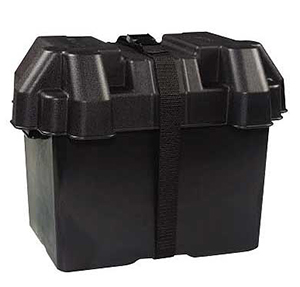
Polypropylene Battery Box for Group 27 or Group 31 battery.
The batteries must be secured so there is no more than one inch of movement in any direction. A loose battery skidding about (weighing about 3/4lb. per amp hour, or 150lb. for a 200Ah battery) is both a physical hazard and a fire hazard. Pre-manufactured, acid-proof battery boxes are available in various sizes and are the best way to safely anchor the batteries.
Use more than one box if your batteries require you to make a series or parallel arrangement. Home-built battery boxes must be ruggedly constructed from marine grade plywood, covered inside and out with fiberglass cloth saturated with several coats of epoxy, and secure even in the event of a capsize. Do not mount batteries directly above or below a fuel tank, fuel line or filter or directly below battery chargers or inverters.
Use Quality Battery Cables
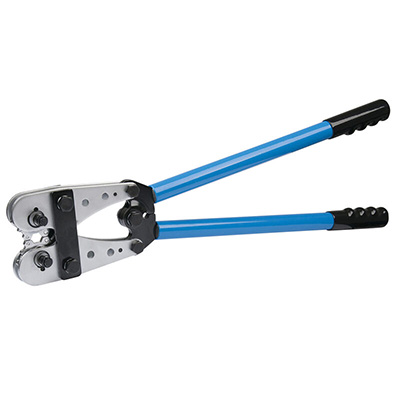
This heavy-duty lug crimper will crimp #8 to 4/0 AWG wire and applies force consistently from all directions to prevent damage to the conductors.
We recommend low-resistance, tinned copper wire in all applications. Moisture, vibration, heat, abrasion and chemicals are major enemies of all electrical system components, and only marine rated wire (like that from Ancor Marine) is built to withstand these conditions.
Be sure to use tin plated copper connectors as well, for the least electrical resistance and the best corrosion protection. We recommend double-crimped terminals, with solid metal-to-metal connections and heat shrink tubing for waterproof protection.
Pre-manufactured battery cables are available in various lengths with well-constructed connectors, properly covered with adhesive-lined heat shrink and terminated with closed barrel ring terminals. However, the lengths available may not be appropriate for your installation so you may have to make your own battery cables.
How to Make Your Own Battery Cables
Step 1. Get a proper battery cable crimper
There is no way to shortcut this since terminals smashed on the cable with a pair of Vise Grips or a few hammer blows will certainly fail, perhaps with catastrophic results.
Step 2. Use closed-barrel terminals with the right size blot holes to be used at the terminations
Keep in mind that positive and negative terminals often have different diameters.
Step 3. Use a corrosion inhibitor
Spray a corrosion inhibitor such as Fluid Film, Lanocote, or Boeshield into the connector before crimping.
Step 4. Seal the connection with heat shrink tubing
Cover the joint between the cable insulation and the connector body with a three-inch section of adhesive-lined heat shrink tubing.
Using a heat gun is the best way to apply heat shrink, although you can use a propane torch with a flame spreader if you are very careful. Be sure to have a fire extinguisher on hand. You can also tape the joint with several layers of quality electrician’s tape and finish it with a small nylon tie where the tape ends to keep it from unwrapping due to heat and solvents. Remember to cover positive terminals with a boot (or the battery box cover) to prevent shorting.
Battery Switches
Traditional OFF-1-2-BOTH Battery Switch

The Add-a-Battery Battery Switch from Blue Seas System's comes with a tradtional battery switch and an automatic charging relay.
Most dual battery setups use a traditional battery switch to control starting the boat and charging the batteries
Prior to starting the engine, the operator would turn the OFF-1-2-BOTH battery selector switch to the BOTH position to have both batteries’ full cranking power. With the engine now running, the switch would stay in the BOTH setting, and both batteries would be charged while powering to the day’s destination.
Once the engine was turned off (while anchored or under sail) the operator would (in theory) return the switch to the 1 or 2 positions, and reserve a battery for starting. When it was time to crank the engine again, the battery switch would be turned to BOTH, or possibly to the reserve battery, and the engine would be started.
If you use this setup on your boat, you have to be careful to not leave the switch in the "both" position once you're stopped. Leaving it in "both" can drain both of your batteries leaving you with no reserve power to start the boat.
Dual Circuit Plus switch and relay combo
The Dual Circuit Plus switch is a simpler alternative to isolate your Start and House circuits. In the ON position, it keeps your batteries isolated, so both can’t be fully discharged by accident. In the COMBINE position, it parallels your batteries in the event of a low Starting battery. Used with the 7610 Automatic Charging Relay (ACR), it automatically combines or isolates your batteries when in the ON position. The most affordable way to purchase the Dual Circuit Plus switch and SI7610 ACR is to buy a battery combiner kit that includes both, the “Add-a-Battery” Dual Circuit System.
Battery Switch Wiring Diagram

This boat dual battery wiring diagram is for the"Add-A-Battery" Dual Circuit System from Blue Sea Systems. The automatic charging relay (ACR) combines the two batteries while charging and isolates the house battery while starting the engine to protect sensitive electronics like your fishfinder, multifunction display or other navigation systems. The switch has a "combine" position as well that will use power from both batteries in the case of a low starting battery to give you more power to crank the engine.
Charge Management
Battery isolators used to be the best method of distributing charging current to multiple battery banks while assuring that they remain electrically isolated during discharge. These devices are electrical “one-way check valves” that allow current to flow to, but not from, the battery. Their disadvantage is that diodes cause a voltage drop that wastes charging energy, creates heat and causes batteries to be undercharged. Alternators with external voltage sensing can correct for the undercharging problem, but voltage drop and the heat generated remain a problem.
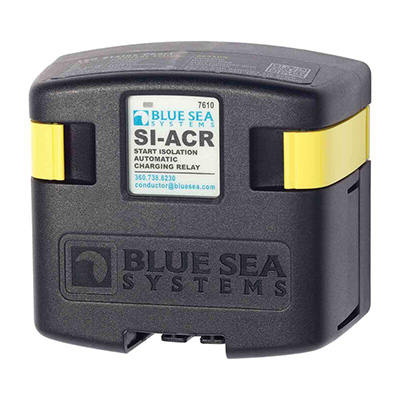
This Starting Isolation (SI) Dual Sensing Automatic Charging Relay from Blue Sea Systems protects your sensitive electronics by temporarily isolating the house loads from the engine circuit during engine cranking.
Automatic Charging Relays (ACRs, also called Voltage Sensitive Relays) are a popular method for achieving the same goal as isolators, but they work on a different principle. Instead of using diodes to block current from flowing in both directions, ACRs use mechanical relays combined with a circuit that senses when a charging source is being applied to either battery.
When a charge is being applied, the ACR closes when the circuit senses that the charge is no longer present, the ACR opens (after a short time delay to assure that the ACR doesn’t open due to temporary voltage sags caused by load startups, like a refrigerator turning on).
Automatic Charging Relays have lots of other uses in addition to isolating the Start and House batteries, and we offer a broad selection now from Blue Sea Systems and BEP Marine. ACRs can be used for load shedding, pilothouse navigation battery isolation, and charge current limiting for a remote battery.
Best Batteries for Dual Boat Battery Setups
Odyssey Extreme Group 31 Dual Purpose Marine AGM Battery

Top features: The Odyssey Extreme Group 31 Dual Purpose Marine AGM Battery is great for boaters that want to run two batteries that function as starting and house bank batteries. Combined with a traditional battery switch, you can use both batteries to start the engine and let the alternator recharge the battery while you're underway. Once you get to your spot, flip the switch to one of the batteries and keep the second as a reserve to crank the engine when it's time to head back.
What makes it stand out: Features Odyssey's Thin Plate Pure Lead (TPPL) construction for extended performance.
West Marine Group 31 Dual Purpose Marine AGM Battery
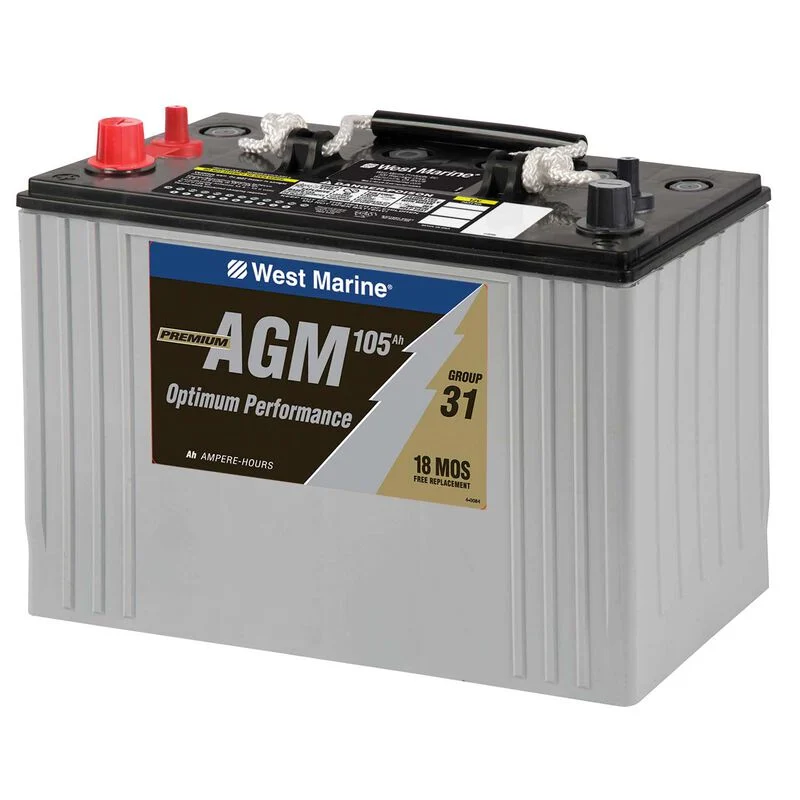
Top features: Our West Marine Group 31 Dual Purpose Marine AGM Battery is a great balance between price and performance. The Absorbed Glass Mat (AGM) construction is rugged and lighter than comparable flooded dual purpose batteries and features a no-spill design. The battery also features high freeze resistance for better all weather performance.
What makes it stand out: Great balance between price and performance.
Relion Group 31 RB100 Lithium Iron Phosphate Deep Cycle Battery
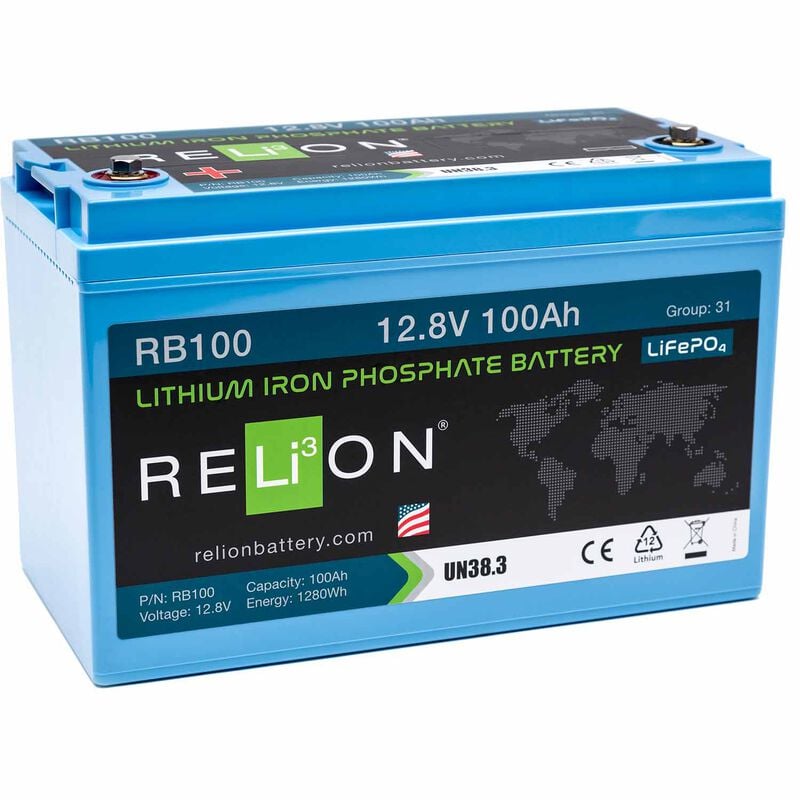
Top features: The Relion Group 31 RB100 Lithium Iron Phosphate Deep Cycle Battery is a deep cycle battery built for handling house loads only. It won't be able to crank your engine, but the lithium iron phosphate construction ensures you'll have full power available throughout discharge without voltage drop like lead-acid batteries. With a 100 amp hour rating, this battery can handle plenty of power hungry gear on your boat.
What makes it stand out: 50-60% less weight than a lead-acid equivalent and full power available throughout discharge.
Installing a Second Battery FAQs
Why should I install a second battery?
A second battery provides extra power for electronics allowing you to stay out longer.
What type of battery should I use?
Choose a deep-cycle battery designed for marine use, such as AGM or gel batteries, for better longevity and performance.
How do I connect the second battery?
Use a battery switch or a battery isolator to add a battery to your electrical system.
Do I need a battery management system?
Yes, we recommend adding one since a battery management system can help monitor charge levels and protect against overcharging and deep discharging.
What size cables do I need?
Use appropriately sized marine-grade cables (typically 4 AWG or larger)
Where should I mount the second battery?
Mount the battery in a ventilated, secure, and dry location, ideally in a designated battery box to prevent movement and exposure.
How do I charge both batteries?
You can charge both batteries using a multi-bank charger or ensure your engine’s alternator is capable of charging both when the boat is running.
What precautions should I take during installation?
Always disconnect the main battery before installation, use insulated tools, and ensure all connections are tight to avoid sparks.
Can I use both batteries simultaneously?
Yes, using a battery switch allows you to select either battery, both in parallel for more capacity, or isolate them as needed.
Conclusion
Adding another battery is a good idea if you want to add a powerful stereo subwoofer system, cabin lighting, electric windlass, wakeboard ballast pump or any of the other electrical and electronic accessories we all want. The installation can be as simple as connecting two batteries in parallel to make one larger battery bank. You can build in redundancy and failure protection with two battery banks, battery switches and charge management devices like ACRs. That way, when you drop anchor and use all your new gadgets, your engine will still start at the end of the day.
Remember that you must match battery chemistries between your banks. If your starting battery is of the lead-acid type, stick to a deep cycle battery of the same chemistry, instead of choosing a gel or AGM battery with different charging requirements.
Need More Help?
West Marine has you covered. From the latest high capacity batteries, to marine-grade connectors and wire, we have what you need. Plus, with a crew of boaters in store, we can help make sure you get everything you need the first time. Find your store here.
Related:
- What is the Best Battery for You?
- How to Select a Marine Battery
- West Marine's Battery Testing Program
- Sizing Your House Battery Bank
- Are Lithium Batteries a Good Choice for You?
- Do-it-Yourself: Installing a Battery Charger
- Selecting a Battery Charger
- Selecting a Marine Storage Battery
- Sizing Your House Battery Bank









